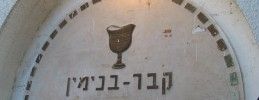Benjamin’s Tomb
June 20th 2014
Benjamin was the youngest son of the Biblical patriarch Jacob and the Biblical matriarch Rachel. His tomb, called Kever Binyamin in Hebrew, is covered by a small building with a domed roof. Today, its location, on a small plot of land between two highways, is incongruous with its urban surroundings.
Although many consider Binyamin’s burial place to be unknown, a 14th century Jewish tradition holds that his tomb is here, in central Israel, just east of the city of Kfar Saba. Muslims likewise greatly respect the memory of Benjamin, calling him Nebi al-Yamin. Indeed, his burial place was originally marked by a Muslim Mamluk ruler named Tankiz.
Benjamin was the head of one of the 12 Tribes of Israel, and his tribal portion includes parts of Jerusalem, along with the Biblical cities of Beit El, Givon and Jericho. The Tribe of Benjamin produced such notable Jewish leaders as King Saul, the first King of Israel, and the prophet Jeremiah, who foretold of the destruction of Solomon’s Holy Temple in Jerusalem.
Out of respect for the Orthodox Jewish practice of separating during prayer, the tomb has divided entrances for men and women. Look for the goblet that appears above the entrance to the tomb, recalling the famous story of how Benjamin’s brother Joseph, acting as the viceroy of Egypt, hid a goblet in Benjamin’s luggage in order to frame him for espionage. The story is told in chapters 42 and 43 of the Book of Genesis. Within the tomb, look up at the domed ceiling and note the words of the blessing Moses gave to the Tribe of Benjamin – “Beloved of the Lord, he rests securely beside Him.” These words come from Deuteronomy 33:12.
In the leafy courtyard surrounding the tomb, look for a blue metal box. If you’re inclined, as many visitors are, to light a memorial candle for Benjamin, this blue box will shield it from the wind. Look carefully at the stones until you see one of the holes shaped like Jewish stars. Depending on when you visit, you may meet a group of young Jewish men from the Breslov Hassidic sect, who frequent this spot. You’ll recognize them by their large kipot and their unusually high level of energy.












